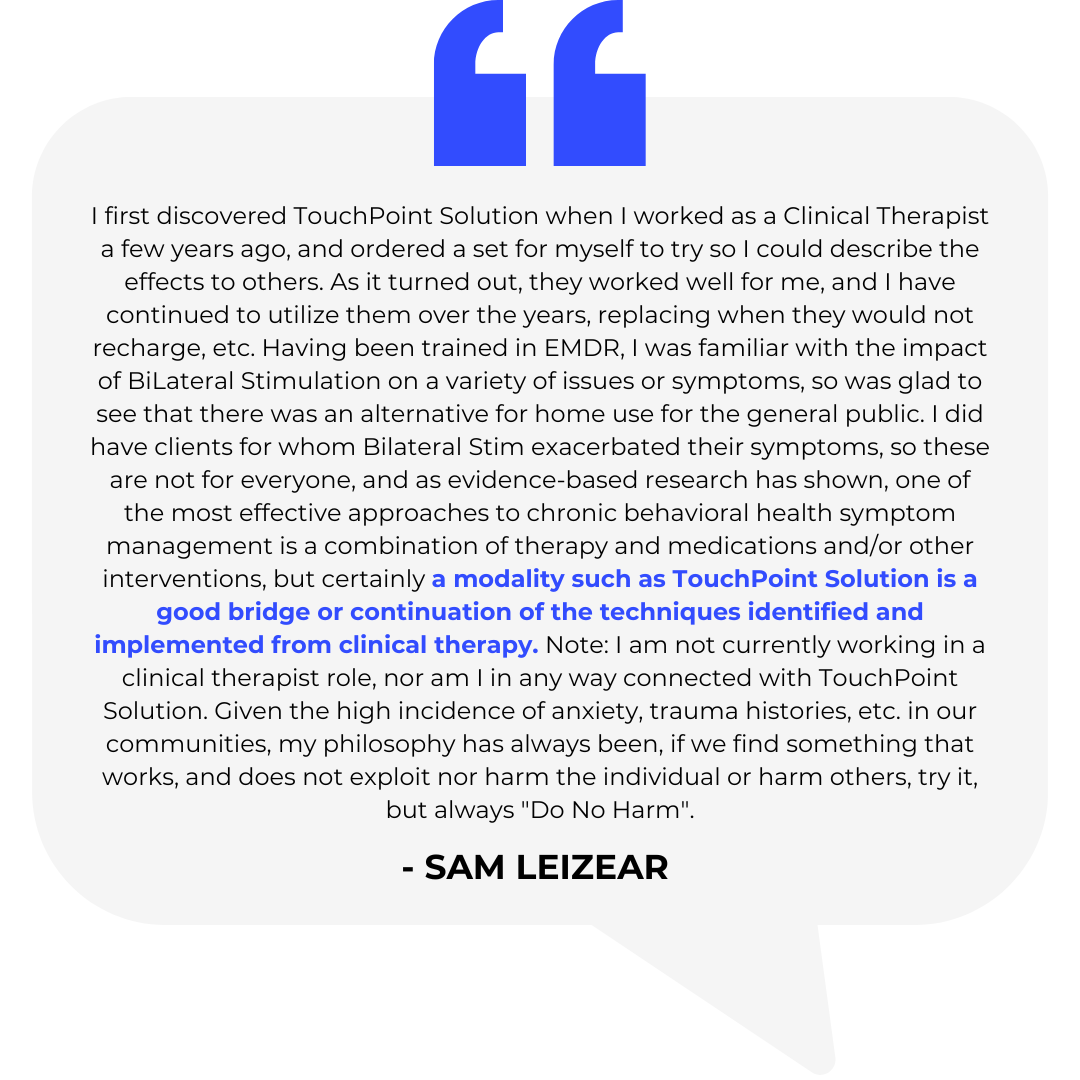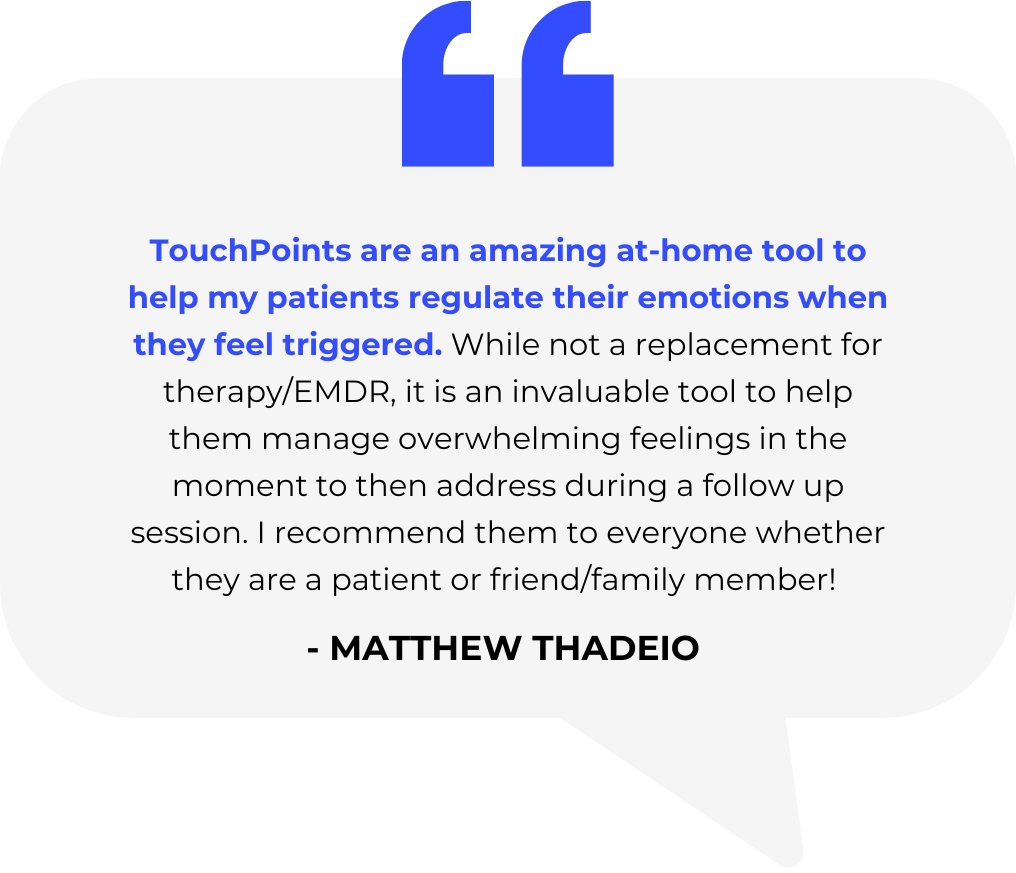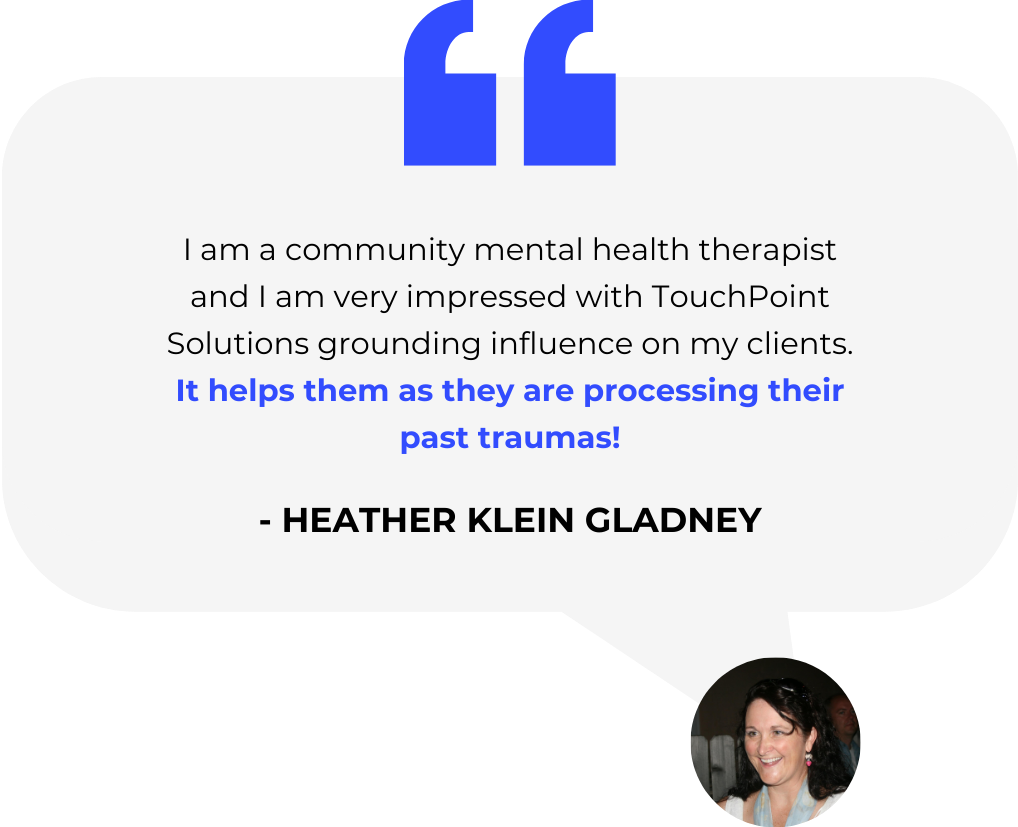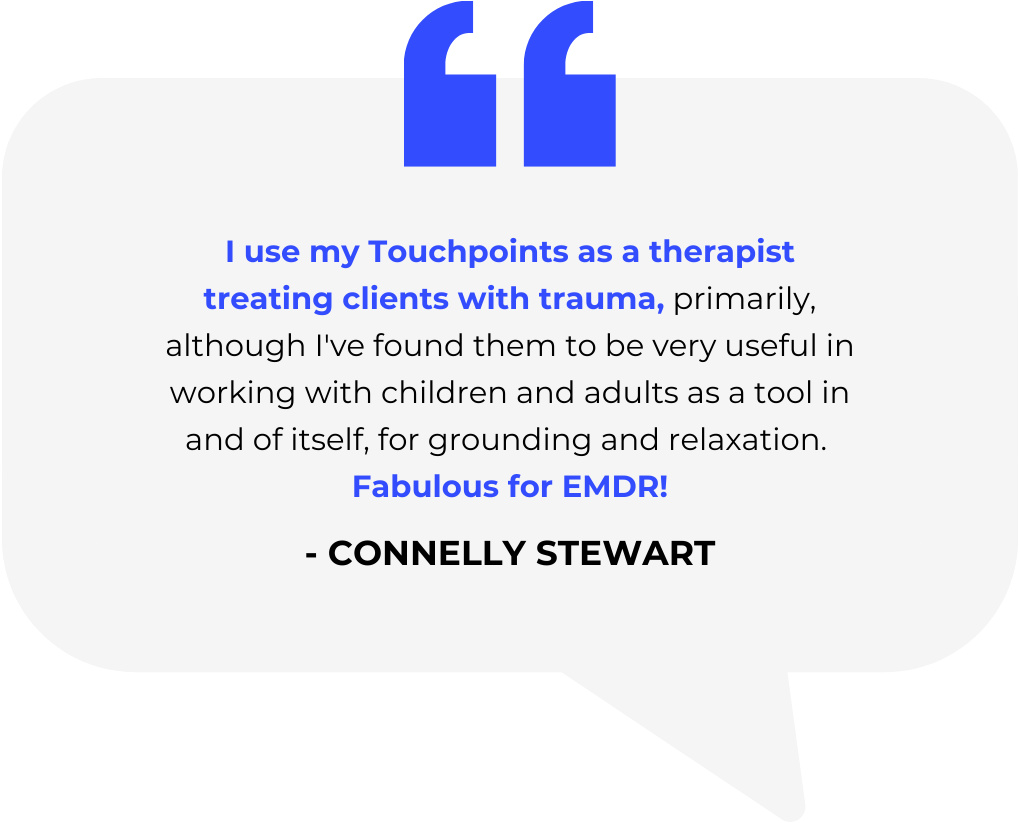Wearable versatility sets TouchPoints apart. Clinicians can easily incorporate them into therapy sessions by having clients wear them as comfortable wristbands, discreetly clipped to their clothing, or held in their hands. This adaptability ensures a seamless integration into various therapeutic approaches.

wireless bilateral stimulation
Ease distress and
improve outcomes.
TouchPoints are clinically proven to calm and refocus
clients, offering support both in session and at home.

wireless bilateral stimulation
Ease distress and
improve outcomes.
TouchPoints are clinically proven to calm and refocus
clients, offering support both in session and at home.

wireless bilateral stimulation
Ease distress and
improve outcomes.
TouchPoints are clinically proven to calm and refocus
clients, offering support both in session and at home.
Rewire the response to stress and trauma
TouchPoints use our proprietary BLAST (bilateral alternating stimulation-tactile) technology. BLAST delivers gentle, alternating vibrations adjust the body’s stress response by calming the nervous system and promoting relaxation.
Unlike wired tappers and devices, TouchPoints are:
- Wearable and hands-free
- Wireless and easy to use
- Adjustable with multiple vibration speeds
- Rechargeable via micro-USB cable


TouchPoints use our proprietary BLAST (bilateral alternating stimulation-tactile) technology. BLAST delivers gentle, alternating vibrations adjust the body’s stress response by calming the nervous system and promoting relaxation.
Unlike wired tappers and devices, TouchPoints are:
- Wearable and hands-free
- Wireless and easy to use
- Adjustable with multiple vibration speeds
- Rechargeable via micro-USB cable


Big Impact, Clinically Proven
Big Impact,
Clinically Proven
Improve Memory Retrieval
Promote relaxation
Reduce EEG Amplitude

How therapists use TouchPoints
Grounding During Intense Emotions
The alternating vibrations help clients stay present and regulate their emotions, making it easier to manage distress during challenging therapy moments.
EMDR Facilitation and Adjunctive Therapy
TouchPoints enhance EMDR sessions by reducing physiological arousal and cognitive distress, allowing clients to resolve difficult emotions more effectively.
Support Between Sessions
Clients can use TouchPoints independently to manage anxiety and stress, reinforcing emotional resilience and self-regulation skills.


How therapists use TouchPoints
Grounding During Intense Emotions
The alternating vibrations help clients stay present and regulate their emotions, making it easier to manage distress during challenging therapy moments.
EMDR Facilitation and Adjunctive Therapy
TouchPoints enhance EMDR sessions by reducing physiological arousal and cognitive distress, allowing clients to resolve difficult emotions more effectively.
Support Between Sessions
Clients can use TouchPoints independently to manage anxiety and stress, reinforcing emotional resilience and self-regulation skills.
Get 50% Off a Set of TouchPoints
This offer is for US and Canada therapists on first-time orders, limited to one set of TouchPoints. Unlimited accessories can be added. Join our Wholesale Program for a full refund or keep your set at this deeply discounted rate. Discount applied at checkout.
Not a therapist? Shop here.


TouchPoints Essentials
$219.99
Ideal for clients who need to wear TouchPoints throughout their day, these clothing clips allow for discreet placement of the devices on or in-between clothing. Perfect for clients who want to integrate TouchPoints without drawing attention in social settings.
TouchPoints Essentials include:
- Set of TouchPoint devices
- Set of clothing clips
- Dual-pronged charging cable
- Free consultation


TouchPoints with Wristbands
$229.99
The wristbands are designed for easy and comfortable use during sessions. They securely hold the TouchPoints in place while offering full mobility, allowing clients to focus on their therapy without discomfort or distraction.
TouchPoints with Wristbands include:
- Set of TouchPoint devices
- Set of silicone wristbands
- Dual-pronged charging cable
- Free consultation


TouchPoints for Sleep
$229.99
Zippered sweatbands are ideal for clients who prefer wearing TouchPoints on their arms or ankles. They ensure a secure fit, muffle vibrations for discretion, and stay comfortable during therapy or daily activities.
TouchPoints for Sleep includes:
- Set of TouchPoint devices
- Set of zippered sweatbands
- Dual-pronged charging cable
- Free consultation
Accessories

Clothing Clips
$9.99

Silicone Wristbands
$29.99

Zippered Sweatbands
$29.99
FEEDBACK FROM PRACTICING CLINICIANS
What Therapists Are Saying
Research Studies

Applied BLAST Evidence from Quantitative Electroencephalogram
This study used quantitative electroencephalograms to measure the impact of TouchPoints on stress. The results showed a significant decrease in excess beta waves (stress) after using TouchPoints.

Effect of Bilateral Alternating Somatosensory Stimulation on Reducing Stress-Related Cortisol
This triple blind placebo-controlled trial with athletes showed TouchPoints stabilized cortisol levels during stressful events and reduced the level of stress points even when cortisol traditionally spikes.

Impact of TouchPoints on Stress Reduction
Analysis from 140 TouchPoints users’ data showed that within 30 seconds of using TouchPoints, people experienced a 74% reduction in stress levels and 68% reduction in body sensations related to stress.
Applications Across Therapies


COGNITIVE BEHAVIORAL THERAPY (CBT)
OCCUPATIONAL THERAPY
In occupational therapy, TouchPoints can be utilized to address sensory processing challenges. BLAST has been shown to improve symptoms of certain movement disorders. The discreet design allows for unobtrusive wear, supporting clients in various daily activities.
Amplify the benefits of mindfulness practices with TouchPoints. BLAST has been shown to change brain wave patterns to those seen in deep meditation. The gentle vibrations also provide a tangible point of focus, aiding clients in achieving a deeper state of relaxation and mindfulness.
TRAUMA-INFORMED CARE
Support trauma recovery by incorporating TouchPoints into trauma-focused therapies. Based on eye movement desensitization and reprocessing (EMDR), BLAST is thought to rewire traumatic memories, decreasing their emotional impact through the establishment of widespread inhibitory cortical connections This can aid in grounding and promoting a sense of safety during sessions.
How to use TouchPoints during an EMDR Therapy Sessions
EMDR therapy is divided into 8 discrete phases. Below we will discuss specifically how TouchPoints™ can be used to assist during each phase.
PHASE 1: HISTORY TAKING
Encourage clients to wear TouchPoints™ from the start to reduce stress during the recall of past events. This helps minimize cognitive and physiological distress, leading to a more efficient resolution.
PHASE 2: PREPARATION
Use TouchPoints™ during this phase to reduce stress associated with the EMDR process, fostering a trusting therapeutic relationship and instilling confidence in calming techniques.
PHASE 3: ASSESSMENT
Wear TouchPoints™ to keep physiological distress minimal, increasing the patient’s confidence in the new positive belief.
PHASE 4: DESENSITIZATION
As a wearable device, TouchPoints™ can be used outside of EMDR sessions to accelerate the desensitization process, reducing stress associated with triggers.
PHASE 5-8: INSTALLATION, BODY SCAN, CLOSURE, RE-EVALUATION
TouchPoints™ throughout these phases to maintain continuity and reduce residual physiological distress, facilitating target resolution and potentially shortening treatment time.










